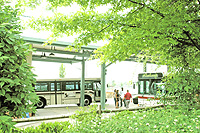Ashevillle Transit – Not Cheap, Just Free!
 |
By Cathy Holt
Would you be more likely to ride the bus if there were evening hours of service? Or if the ride were free? If you have never used
On May 16 Asheville City Council approved funding to extend “basic” transit services into the evening and implement a 90-day “ride-for-free” promotion period. Evening service will begin on July 1; the free ride promotion period will start August 14. The cost of about $300,000 will come from the city\’s parking fund. The city has already introduced newly designed route maps, available at the transit center on
Ave
town.
“At every citizen input forum, we’ve heard the need for extension of bus service into the evening,” said Council member Brownie Newman, a transit advocate for many years. “The current schedule makes it impossible for many people to use the buses. So we will extend basic transit service into the evening, into each part of town. By making transit free for a 90-day period, we hope to recruit new riders.”
According to Newman, “Many communities have found it very effective to make the buses free, even for a limited period of time. When
City Council hopes to grow transit ridership by 15% this year, more than triple the transit system’s average rate of increase. “On Friday and Saturday evenings, the buses will run even later,” says Newman. “If we see a big increase in ridership this year, then we can begin to add higher frequency.”
Current Use
More than 60 percent of
Among the benefits mentioned by advocates of public transit are saving the trouble and cost of parking and improvements in air quality. Transportation is the second highest annual expense for American families, exceeded only by housing. The American Automobile Association estimates Americans spend over $8,000 per year buying, repairing, insuring and operating their cars. Eliminating one car in a household can free up thousands of dollars to meet other family needs.
“When Katrina came and there was a fuel shortage and price spike, we picked up a significant number of riders,” says Bruce Black, head of the Asheville Transit System. “We picked up 340-350 trips a day and retained 60% of those. We have had a 20% increase in ridership over the last five years; this year alone, we had an 8% increase in ridership, while the previous average was between four and five percent.”
Improved transit benefits the entire community. All forms of transportation are subsidized, none more than the private automobile. Recently shelved plans for a new parking deck would have cost $30 thousand per parking space. A study by the Economic Policy Institute found that investing in transit infrastructure yields a bigger, quicker payoff than an equivalent investment in highways — and has more potential for stimulating long-term economic growth. And as ridership goes up, the subsidy per rider drops. As airlines discovered long ago, a scheduled plane will take off whether seats are filled or not; it\’s more cost-effective to sell seats at bargain rates to last-minute fliers than to leave them empty.
Funding the System
In Asheville North Carolina Asheville Black Mountain , with Warren Wilson College
Despite the fact that Asheville Transit System recently surpassed 1 million riders, the system is threatened by federal cutbacks. Funds provided by the federal government help offset operating costs for metropolitan areas under 200,000 population. Recently, the Census Bureau redefined the Asheville
“It’s nonsensical to call Asheville Black Mountain Asheville Washington
Newman is equally concerned: “The new census definition means we’re forced to follow regulations that are intended for much larger cities; hence, we may be losing local control over federal funding for transit, which would mean a dramatic loss of operating funds to run the Asheville Transit System. It’s a very serious situation [that] will cripple our transit system at the same time that there’s very strong community support and political support to take big steps forward.”
Newman says that Congressman Taylor and Senator Burr’s offices have both indicated some support for passing legislation that would fix the problem. Meanwhile, he says, city funding is limited. “Street parking and tickets generate a million dollars a year, and in the past we took 100% of that for just building parking garages. This year, the city appropriated about $100K for public transit to make up for the initial shortfall due to these federal regulations.”
Capital Costs
City Councillor Bryan Freeborn, who has served on the board of the Transit Commission for two years, notes that growth in ridership will lead to more capital investment. “When we implement the fare-free program and extend our hours, we’ll be running our buses more often and they won’t last as long, and we’ll need more buses. It takes a year to get a bus from the time you order it. We need to prepare ourselves to double the amount of spending on transit, from $3.5 million to $7 million over the next five years,” he said.
Newman and Freeborn both favor a broader Transportation Demand Management program, through which the city partners with educational institutions and businesses so students or employees can ride free all the time. Newman says, “It’s a win-win because the businesses and schools pay the transit system directly, and they save by not having to build garages or parking facilities. UNCA has a ‘freshmen can’t have cars’ policy. Mission Hospital
Before moving to Asheville
Greener, Cleaner Transit
Greener vehicles are also planned; noise and fumes are the main complaints about buses. Black says the city has arranged with Caterpillar Corporation to retrofit the Asheville
As for Park ‘n Ride lots, Newman says, “We have a 130,000 daytime population in downtown Asheville Asheville is the job center and commercial hub of Western North Carolina . Park ‘n Rides are ideal for that, once we have the increased commute hour service. For infrastructure, we’d need parking lots on Merrimon
Avenue Patton Avenue West
Tunnel Road , Hendersonville
lease church lots, which are not utilized on weekdays.”
Avenue
lease church lots, which are not utilized on weekdays.”
More density in the urban core and a multi-modal transportation approach that includes transit, sidewalks, greenways, bike paths would help make higher frequency transit more feasible. “We are already experiencing some infill (as well as sprawl),” says Newman. “There’s a 10-story building going up, and a five-story building that’s going to be green and affordable housing on lower Coxe Avenue. Before buses, Asheville
electric streetcar system served Weaverville as well as all parts of
town,” he said. “If we restored some limited streetcar service,
tourists would love it, it would be enormously popular and put Asheville
electric streetcar system served Weaverville as well as all parts of
town,” he said. “If we restored some limited streetcar service,
tourists would love it, it would be enormously popular and put
“The
NCDOT says we have to build an eight-lane highway through West
Asheville because the transportation models all show that people will
be driving this many cars a day 20 years from now,” Newman continued.
“These models assume that the numbers of people walking, biking, and
using transit will be the same then as they are now. But once we start
making other options viable, DOT won’t need to tear up West Asheville for an over-sized $250 million road project.
Let’s build on the success of these other strategies first, which will lay the
foundation for much bigger things in the future.”
NCDOT says we have to build an eight-lane highway through West
Asheville because the transportation models all show that people will
be driving this many cars a day 20 years from now,” Newman continued.
“These models assume that the numbers of people walking, biking, and
using transit will be the same then as they are now. But once we start
making other options viable, DOT won’t need to tear up
Let’s build on the success of these other strategies first, which will lay the
foundation for much bigger things in the future.”








